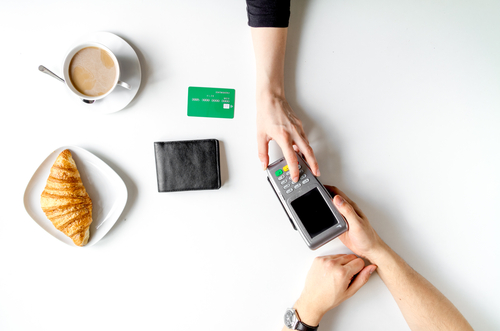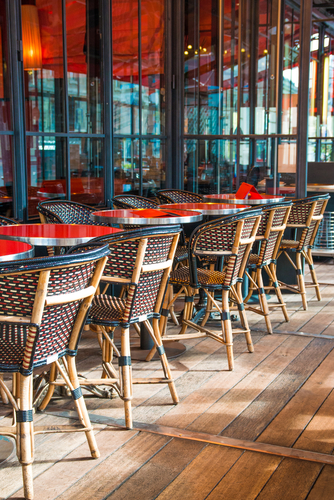It’s been like a slow-moving locomotive just pulling out of a station but pay at the table technology adoption at fine dining and quick service restaurants is inching forward. New payment methods like EMV, mobile wallets, and contactless payments are inciting restauranteurs to action but not at the pace the credit card companies expected in the U.S.
The National Restaurant Association’s (NRA) State of the Industry Report showed that 32% of diners believe restaurants are lagging behind in the pay at the table technology department. Which begs the question, why has the industry been so hesitant to implement the process?
Well, it’s hard to pinpoint exactly, but studies are showing that customers, on the other hand, are all for it.
 Diners Want to Pay at the Table
Diners Want to Pay at the Table
The biggest surprise in the slow adoption rate is the fact that the general public is not averse to the idea. It would make sense if patrons were simply against the whole concept but that is not the case at all. Additionally, reports show that mobile technology leaves a favorable impression on guests.
61% of diners agree that server handheld tablets improve their guest experience. – NRA Survey
There is something about being handed a tablet or a sleek mobile device at the end of the meal that takes service to the next level. Plus, there’s no multiple copies of paperwork to fill out, no clutter of paperwork left behind with a pen and a dirty credit card book. It gives a high-end impression of quality and heightened security since the credit card never leaves the table.
 Overcoming the Awkward Factor
Overcoming the Awkward Factor
Admittedly, there can be an awkward factor with the pay at the table check out process wherein the server stands idly by for a moment while the guest goes through the tipping process. It may work out in the server’s favor, though, as an unhappy guest might be less likely to leave a lower tip with the offending party present, or vice versa, it may motivate a higher tip during a round of table side banter as the check is signed by a delighted customer.
Those awkward situations are going by the wayside, however, as pay–at-the-table technology matures and the hardware and software related to pay at the table processes evolve. Tips can now be added with the touch of a button with some systems. Consumers are presented with tip amount options that are pre-calculated, eliminating the need to do math in their heads or to pull out their tip calculator apps. Some pay at the table devices are designed to be left at the table, too, making the awkward moment nonexistent.
Beatta McInerney, business development manager at ScanSource and payments expert says, “Pay at the table tips are better since they’re prompts instead of calculations. Plus, pay at the table feels like better service and a better experience so the tip may be higher.”
Streamlining Workflows with Pay at the Table Technology
You and your customers have a common goal. Once the check is requested both of you want the process to go as quickly and as smoothly as possible. Your guests may have just enjoyed a leisurely and delicious meal at your establishment but for those who have tickets to a show after dinner or have to get home to relieve a babysitter, they don’t have the luxury to wait 15 to 20 minutes to pay the bill.
A traditional restaurant payment process goes something like this:
- Customer requests check
- Server makes his way to the point of sale (POS) terminal to print the check, possibly splitting checks
- Server presents the check to the customer
- Server waits for customers to slip payment into bill fold
- Server picks up the check and returns to the POS terminal and runs payment card
- Server returns back to the guest with the payment card and receipts
- Server waits for guest to sign the check
- Server makes his third trip back to the POS terminal
- Server closes out the check
Compare that to a typical pay at the table process which is more streamlined.
- Customer requests check
- Server arrives at the table with a tablet / mobile payment device and swipes the customer’s card
- Server hands the tablet mobile payment device to the guest to add the tip and sign the screen
- Check is closed
 Upgrading to Pay at the Table Technology Paves the Way for New Payment Methods
Upgrading to Pay at the Table Technology Paves the Way for New Payment Methods
Two years after the EMV liability shift in the U.S., less than half—only 42%– of restaurants have upgraded to EMV technology. The remaining restaurants without EMV-capable technology are liable for chargebacks and fines when a fraudulent or counterfeit card is used for payment. Moreover, they are using a technology that’s inferior from a security perspective. EMV chip cards create a unique transaction code, making the cards virtually impossible to counterfeit.
McInerney says that restaurants are now starting to feel the pain of chargebacks from not accepting chip cards. “They are getting killed with friendly fraud, where guests will call the credit card processor to reverse the charges. Non-EMV compliant restaurants have to pay up,” she says. The loss of revenue is now motivating restaurants to finally get on the EMV train.
As more restaurants meet consumer expectations and incorporate pay at the table technology into their processes, those upgrades are likely to include EMV payment capability, helping to drive adoption. Restaurant operators can also gain near-field communication (NFC) capabilities that can enable them to accept contactless payments and mobile wallet payments such as Apple Pay, Samsung Pay and Android Pay when they upgrade to a pay at the table solution. Pay at the table mobile options eliminate the server having to remove the credit card from the table, put guests in control and therefore limit the risks of credit card fraud at your restaurant.
Pay at the Table Completes the Customer Experience
Most diners, and especially those that are well traveled are used to pay at the table processes since the mobile technology is ubiquitous across Europe, Canada and other countries. Your guests most certainly expect it and are hoping for it in the U.S. in larger numbers, for time savings, security, convenience, and an easy and efficient way to cap off a great dining experience.
The good news is that pay at the table technology is gaining acceptance with restaurant chains as they see the value in better security, better customer service, and table turns. And with secure Payment Gateways, it’s easier to have a certified solution available to all franchisees without big upfront costs.
If you’d like to learn more about technologies that are driving value, efficiencies and customer experiences for restaurant chains, visit our blog
Restaurant technologies, 7 solutions you can’t afford to miss

Betta McInerney is a Business Development Manager with ScanSource working with resellers and ISVs to bring payments solutions to market. Thanks Beatta for sharing your expertise and insights with us!
 Overcoming the Awkward Factor
Overcoming the Awkward Factor Upgrading to Pay at the Table Technology Paves the Way for New Payment Methods
Upgrading to Pay at the Table Technology Paves the Way for New Payment Methods